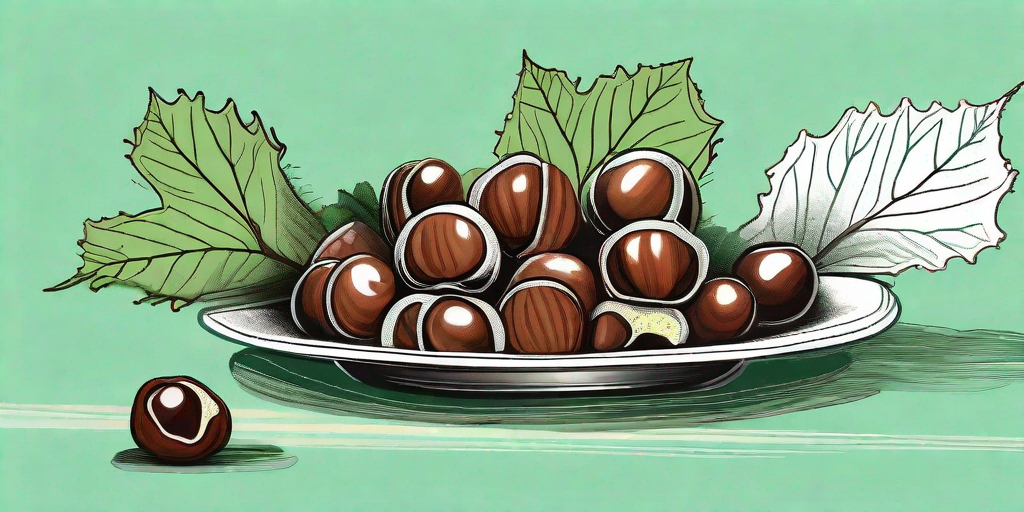
Ah, the humble horse chestnut. Known to many as the star of autumnal schoolyard games, this shiny brown nut has a reputation that extends far beyond the realm of conkers. But did you know that it can also be a part of your culinary repertoire? Yes, you read that right. Today, we're going on a gastronomic adventure, exploring the edibility of horse chestnuts.
The Horse Chestnut: A Brief Introduction
Before we delve into the culinary potential of horse chestnuts, let's take a moment to appreciate their natural beauty. Encased in a spiky green shell, the horse chestnut (Aesculus hippocastanum) is a sight to behold. Native to the Balkan Peninsula, these trees have spread across the globe, gracing parks and gardens with their majestic presence.
Despite their name, horse chestnuts are not true chestnuts. They belong to a different family of trees and shrubs known as the soapberry family. The name 'horse chestnut' is thought to come from the horseshoe-like scars left on the twigs after the leaves fall. Now, isn't that a fun fact to share at your next dinner party?
The Edibility of Horse Chestnuts
Now, onto the question that's been burning in your mind: can you eat horse chestnuts? The answer is yes, but with a caveat. Raw horse chestnuts contain a compound called esculin, which can be toxic if consumed in large quantities. But don't let that deter you! When properly prepared, horse chestnuts can be a delicious and nutritious addition to your diet.
So, how do you prepare horse chestnuts for consumption? The key is to leach out the esculin, which can be achieved through a process of boiling and soaking. Once this is done, you're left with a nut that's rich in starch and can be used in a variety of dishes.
Preparing Horse Chestnuts: A Step-by-Step Guide
- First, gather your horse chestnuts. Look for nuts that are firm and free from holes or cracks.
- Using a sharp knife, make a cross on the flat side of each nut. This will allow the water to penetrate the shell during boiling.
- Boil the chestnuts for approximately 15 minutes. This will soften the shells and begin the process of leaching out the esculin.
- Drain the chestnuts and allow them to cool. Once they're cool enough to handle, peel off the shells and the thin skin underneath.
- Soak the peeled chestnuts in cold water for at least 48 hours, changing the water at least twice a day. This will remove any remaining esculin.
- After soaking, the chestnuts are ready to be cooked and eaten. Enjoy!
Culinary Uses of Horse Chestnuts
Now that you know how to prepare horse chestnuts, let's explore some of the ways you can incorporate them into your meals. From soups to desserts, the possibilities are endless!
One of the most traditional uses of horse chestnuts is in a dish called marrons glacés. This French delicacy involves candying the chestnuts in sugar syrup and glazing them with sugar. The result is a sweet treat that's perfect for the festive season.
Recipe Ideas
- Horse Chestnut Soup: Blend cooked horse chestnuts with vegetable stock and cream for a rich and hearty soup.
- Horse Chestnut Stuffing: Add a unique twist to your roast dinner with a stuffing made from horse chestnuts, breadcrumbs, and herbs.
- Horse Chestnut Pancakes: Replace some of the flour in your pancake batter with ground horse chestnuts for a nutty flavor and extra nutrition.
Frequently Asked Questions
Are horse chestnuts poisonous?
Raw horse chestnuts contain a compound called esculin, which can be toxic if consumed in large quantities. However, when properly prepared through a process of boiling and soaking, horse chestnuts are safe to eat.
What's the difference between horse chestnuts and sweet chestnuts?
Horse chestnuts and sweet chestnuts are different species. Sweet chestnuts are edible and have a sweet taste, while horse chestnuts are bitter and need to be prepared carefully to remove the toxic compound esculin.
Can I use horse chestnuts as a substitute for regular chestnuts in recipes?
Yes, you can use horse chestnuts as a substitute for regular chestnuts in recipes, but remember that they need to be prepared properly to remove the esculin. Also, horse chestnuts have a more starchy texture and a less sweet flavor than regular chestnuts.
So, there you have it. From conkers to cuisine, the horse chestnut is a versatile nut that deserves a place in your kitchen. Just remember to prepare them properly, and you'll be rewarded with a unique ingredient that can add a touch of novelty to your meals. Happy cooking!















